|

Andromeda is a large northern constellation visible in both the Northern and the Southern hemispheres. The
mythology concerning Andromeda, referred to as the "chained lady," is linked to the mythology
of the constellations of Perseus and Cassiopeia, which border Andromeda on the east and north, respectively, and the slightly more distant constellations Cetus and Cepheus. Andromeda is usually represented as lying down, in chains, with her arms outstretched, in preparation for sacrifice. The brightest
star in Andromeda, the second-magnitude Alpheratz, represents Andromeda's head, in the southwestern portion of the constellation.
It is also the northeastern star in the Great Square of Pegasus, making Andromeda easy to find in the sky. The constellation is best known as the home of the Andromeda galaxy.

Canis Major is a bright southern constellation. It lies south of the celestial equator. Canis Major's (Latin for "greater dog") most
distinctive feature is Sirius, the brightest star in the night sky. Canis Major lies southeast of the constellation Orion
(the Hunter), and Sirius falls along an imaginary line drawn through Orion's three central stars, or "belt." The basic figure
of Canis Major also includes the bright stars immediately to the east and west of Sirius and the triangle of stars to the
southeast.
Canis Major and the constellation Canis Minor, the "lesser dog," are widely regarded as two hunting hounds that follow Orion, the great hunter of ancient Greek legends.
The hounds are often pictured chasing a hare, represented by the constellation Lepus, which lies west of Canis Major at Orion's
feet.
According to early Greek mythology, the constellation represented
Laelaps, a hunting dog with various masters. Among these masters was Actaeon, a great hunter who accidentally saw Artemis,
the goddess of the hunt, naked. As punishment, Artemis turned Actaeon into a stag, and his hounds chased and killed him. Other
legends say that Laelaps originally belonged to Artemis, and that the divine hound could catch anything he chased.
Canis Minor is a small constellation that has only two distinctive
stars. It lies just north of the celestial equator and can therefore be observed from most parts of the Northern and Southern
Hemispheres.
In legend, Canis Minor -- Latin for "lesser dog" -- is usually
associated with Canis Major. These two hounds belonged to Orion, the mighty hunter of Greek mythology, and explains why the
two dogs chase the nearby constellation Lepus (the Hare) across the sky. In some legends, however, Canis Minor and Canis
Major claim other masters, including the legendary hunter Actaeon.
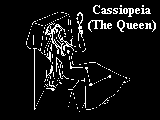
Cassiopeia is bordered on the north and west by Cepheus, on the south by
Andromeda, and on the southeast by Perseus -- constellations to which it is related through mythology and star lore. The
five important stars of the constellation form a distinctive, irregular W in the sky. Cassiopeia is known for its wealth of
multiple stars and open star clusters. Two of its galaxies are companions of the famous Andromeda galaxy.
In Greek mythology, Cassiopeia was a vain Ethiopian queen who put the life
of her daughter Andromeda in danger. Cassiopeia was married to Cepheus, king of Ethiopia. She offended the Nereids, or sea
nymphs, when she boasted she was more beautiful than they. To punish her for her vanity the Nereids had Poseidon, god of the
seas, send a monster to plague the shores of the kingdom.When King Cepheus consulted the oracle for help, he was told that
only by sacrificing the beautiful Andromeda could he appese the gods and avert destruction of the kingdom. He chained Andromeda
to a rock, but she was saved by the hero Perseus. When Cassiopeia was placed in the heavens after her death, in order
to humble her she was positioned so that she would have to spend half of her time upside down and bound to a chair.
This explains the constellation's apparent change of position as it circles the sky; sometimes it is shaped like the
letter W, and sometimes its upside-down, appearing like an M. Cassiopeia is sometimes referred to as the "lady in the chair".

Centaurus is a constellation fo the Southern Hemisphere. Centaurus (the Latin form of centaur (a mythical half-man,
half-horse creature)) lies due south of the tail of Hydra (the Water Snake), and the very bright star Spica in Virgo.
Centaurus, the ninth largest constellation in the sky, is rich in history and contains a number of significant astronomical
objects, including the star closest ot the solar system.
Observers in southern regions can see that Centaurus is one
of the handful of constellations whose star pattern actually resembles the image it is said to represent. A bulging rectangle
of five bright stars outlines the centaur's body. Zigzagging lines of stars at the northeast and southweat corners form the
arms and hind legs, respectively. The two brightest stars in Centaurus mark the front feet.
According to the Greeks, Centaurus represented Chiron, a
mild-mannered scholar and healer and the most famous of the centaurs, a race of creatures known for their rowdiness, drunkenness,
and brawling. He ran a school at the summit of Mount Pelion, where he taught music, botany, astronomy, and medicine and was
a mentor to a number of the most celebrated Greek gods and heroes, including Heracles (called Hercules by the Romans), Jason,
Odysseus, Theseus, and Achilles. Chiron earned his place in the sky after Heracles accidentally shot him with one of his poison
arrows. Wounded and in intense pain, Chiron could not die because he was immortal. Achilles, who attended him on his sickbed,
was unable to bear the sight of his beloved teacher's suffering. He begged Zeus to let Chiron die. The chief god did so, placing
him in the heavens as a constellation.

Cepheus is a large north circumpolar constellation. In Greek mythology, Cepheus was the king of Ethiopia. Cepheus, which comes from
the Greek word meaning "gardener," is one of four mythologically related constellations, called the Royal Family, that are
found in close proximity in the sky. The constellation is bordered on the east by Cassiopeia, the king's wife, and Cassiopeia
in turn borders Andromeda and Perseus, representing the royal couple's daughter and son-in-law. Andromeda was the unfortunate
maiden chained to the rocks as a sacrifice to Cetus, the sea monster, in retribution for Cassiopeia's vanity. Perseus, the
hero, rescued Andromeda and later won the benefaction of Cassiopeia by turning his rival into stone at a wedding banquet Cepheus
gave the young couple. Some legends place Cepheus with Jason on the Argos in search of the Golden Fleece. Cepheus and
17 of his 20 sons died in battle with Hercules over control of Sparta. Because Cepheus was distantly related to Zeus, it was
easy for him to gain a place in the heavens. Cassiopeia joined him in the sky, where she sits in a chair.
Section 1 Quiz

SECTION 2

Cetus is a constellation visible in both the Northern and Southern Hemispheres. Although Cetus is Latin for "whale,"
the constellation is traditionally figured as a sea monster with paws, a rearing head like a dog's, and a curled fish's tail.
It is sometimes shown lounging on the banks of the river constellation, Eridanus. Cetus lies south of Aries and Pisces and
spans the celestial equator. With an area of 1,231 square degrees, Cetus is the fourth largest constellation. However, it
consists entirely of fairly dim stars, so it is somewhat difficult to identify.
In Greek mythology, Cetus was the monster
sent to devour Andromeda. According to one account, Andromeda's mother, the queen Cassiopeia, bragged that she was more beautiful
than the sea nymphs. To punish Cassiopeia for her pride, Poseidon sent the monster to terrorize the kingdom. The oracle
proclaimed that only the sacrifice of Andromeda would save the realm. Reluctantly, Cassiopeia and her husband, the king Cepheus,
chained Andromeda to the cliffs overlooking the sea. With the monster approaching the maiden, Perseus happened to be flying
by on the winged horse Pegasus. When he saw Andromeda, he fell in love with her. He attacked the sea beast, killed it, and
rescued Andromeda.

Coma Berenices is a faint northern constellation that is visible from both the Northern and the Southern Hemispheres.
Coma Berenices (Berenice's Hair) is bordered on the south by Virgo and on the west by Leo, which share in its history and mythology. Alothough the ancient Greeks recognized this group of stars, they did not consider
it a separate constellation but referred to it as the tuft of hair at the end of Leo's tail or as a distaff or sheaf of wheat
held by Virgo.
The name Berenice in Greek means "victory bearer," and the constellation's
name comes from an Egyptian story that has some historical basis. In the time of Ptolemy III, Euergetes -- an Egyptian king
in the mid-3rd century BC -- the king was about to engage in war against the Assyrians. His queen, Berenice, vowed that she
would sacrifice her hair on the altar of Aphrodite if he returned home safely. She fulfilled her promise on his safe return,
but the next day her hair was missing. A Greek astronomer and mathematician, Conon of Samos, told the king that Berenice's
hair had been transferred to the heavens because Aphrodite was pleased with the sacriice, and he pointed to the cluster of
stars close to the tail of leo to confirm his explanation of the missing hair.
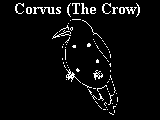
Corvus is a constellation of both the Northern and Southern Hemispheres. Corvus, Latin for "crow," is a small constellation said
to represent Apollo's crow. In Greek mythology, the crow is said to be sacred to the god Apollo, who transformed himself into
the bird to escape the fearsome monster Typhon. The crow is usually pictured perched along with Crater (the Cup) on the back of Hydra (the Water Snake).
Corvus is made up of four chief stars arrayed in a trapezoid
designating the crow's body, with two stars at opposite corners representing the beak and tail. The Romans gave the constellation
its present name.
Crater is a constellation of both the Northern and Southern Hemispheres.
Crater, Latin for "cup," is a small constellation made up of about eight medium-bright stars arrayed roughly in a horseshoe
shape. It is usually pictured as a double-handled goblet resting along with Corvus (the Crow) on the back of Hydra (the Water
Snake).
In Greek mythology, Crater has been associated with a number of gods and
heroes, including Dionysus, Heracles, and Achilles, but it is most often linked with the god Apollo, who sent the cup with
his pet crow to get water. When the crow returned late, Apollo condemned it to eternal thirst by placing it in the sky with
the water goblet just out of its reach.
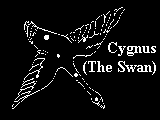
Cygnus is an ancient northern constellation visible from both the Northern and Southern Hemispheres. Cygnus is Latin for "swan,"
but the constellation is also called the Northern Cross because of the large, distinctive cross shape formed by its brightest
stars. It is situated west of the costellatoin Pegasus, north of Vulpecula, and east of Lyra, and the swan is traditionally pictured as flying south, down the Milky Way.
Cygnus is named for the swan whose form the Greek god Zeus
assumed in order to seduce Leda the wife of the Spartan king Tyndareus. As a result of this uniion, Leda later gave birth
by laying two eggs. From one egg were born her sons Castor and Plydeuces (Pollux), the twins later placed in the sky as the
constellation Gemini; her daughters Clytemnestra and Helen of Troy were born from the other egg. The latter were sired by Zeus, according
to the myth. In other versions Zeus was the father of Pollux, but Castor was born of Leda's union with her husband that same
night. Still another tail has Cygnus as a mortal or demi-mortal who was changed into a swan and placed in the heavens by Apollo,
the sun god.
Delphinus is a constellation of the Northern Hemisphere. Delphinus lies between the constellations Pegasus and Aquila just north of the celestial equator.
Delphinus is Latin for "dolphin," and historians have traced the dolphin
symbolism back to ancient times. The constellation's image as a marine creatrue -- dolphin, fish, or porpoise -- was shared
by a number of ancient cultures, including the Greeks, Arabs, Romans, and East Indian and the many stories featuring the dolphin
all celebrate this animal's friendliness and sevice to gods and humans. According to one Greek myth, Poseidon sent a dolphin
to persuade a reluctant sea nymph to marry him. The dolphin was successful, and Poseidon showed his appreciation by raising
the dophin into the heavens. In another Greek tale, a dolphin rescued the musician Arion, who had jumped into the sea to escape
murderous sailors intent on stealing prize money he had won by playing the lyre. In that story, the nearby constellation Lyra
represents Arion's instrument.

Draco is a constellation of the Northern Hemisphere. Draco, Latin for "dragon," is the ninth largest constellation, occupying
1,083 square degrees.
Draco is connected with two stories in Greek mythology. The
constellation symbolized the dragon Ladon, who guarded the goddess Hera's golden apples in the garden of Hesperides. To complete
on of his 12 labors, Heracles killed Ladon in order to steal the apples. Hera honored her servant by granting him a place
in the sky. Draco also is associated with the dragon slain by the mythical hero Cadmus. Cadmus planted the dragon's teeth,
and an army of soldiers called the Sown Men sprouted from them. Some of the Sown Men then helped Cadmus build the city of
Thebes on the site.
Lepus is a small constellation located immediately south of Orion, the brightest constellation in the sky. Lepus (Latin for "hare") lies just south of the celestial equator and can be observed
from most parts of both the Northern and the Southern Hemispheres.
In most descriptions, Lepus represents a hare running
at Orion's feet. This arrangement suits legends of Orion, the mighty hunter of ancient Greek mythology, who enjoyed hunting
hares. In pursuit of Lepus are Orion's two dogs, the constellations Canis Major and Canis Minor. One of the Greek legends
connects Lepus iwth the early inhabitants of the island Leros. These people brought hares to the island and allowed them to
multiply without restraint. Leros soon became overrun with hares, which were driven out with great difficulty. As a testament
to the benefit of moderation, the people of Leros placed the image of a hare in the sky.
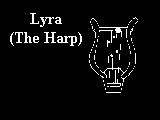
Lyra is a constellation of the Northern Hemisphere. Lyra,
Latin for "lyre," is a small but prominent constellation, significant both historically and astronomically. It consists of
a smallish group of bright stars usually pictured as the stringed instrument known as the lyre, often shown in front of an
eagle or other bird. Lyra lies between Cygnus and Hercules high overhead in the summer sky.
As the instrument played by the musically gifted god Orpheus,
Lyra is associated with many Greek myths. Hermes was said to have invented the lyre by stretching gut strings across a
turtle shell. Hermes gave the lyre to Apollo, who in turn gave it to Orpheus. Orpheus traveled with Jason and the Argonauts
on the quest of the Golden Fleece. He saved the crew from the sirens (beautiful sea nymphs who lured sailors to their death
with their singing) by drowning out their songs with his playing. According to another story, when his wife, Eurydice, died,
Orpheus gained entrance to the underworld by charming the gods and guardians there with his playing. Persephone was so moved
that she agreed to let him take Eurydice back to the world of the living on the condition that he not look at her. But at
the last moment, he could not resist one peek and Eurydice diappeared back into the land of the dead as a wisp of smoke.
Ophiuchus is a large but relatively faint constellation. It stretches across the celestial equator and therefore can be observed from
almost any part of the world.
Ophiuchus divides the constellation Serpens, whose two parts, Serpens Cauda and Serpens Caput, stretch eastward and westward from the borders of Ophiuchus. The bright
southern constellation Scorpius lies directly south of Ophiuchus.
The name Ophiuchus is derived from the Greek words for "serpent holder."
The constellation is usually pictured as an adult man holding a serpent, represented by Serpens, which coils around his waist.
The Greeks considered Ophiuchus to be the image of Asclepius, the god of
medicine. The parents of Asclepius were gods Apollo and Coronis, but he was raised by the wise centaur Chiron, who taught
the boy the practice of healing. Asclepius quickly became a gifted healer and eventually learned to bring the dead back to
life. Hades, the god of the underworld, complained that Asclepius' work would deprive him of dead souls. Zeus, Hades'
brother and king of the gods, agreed, and killed Asclepius with a thunderbolt. When Apollo protested the execution of this
son, Zeus placed Asclepius among the stars. In many accounts, Asclepius learned from serpents to raise the dead. According
to Greek legend, serpents are reborn each time they shed their skin. From this legend the serpent became a symbol of medicien
in Western cultures -- as seen in the caduceus, the insignia of a staff with two entwined snakes, symbolizing a physician.
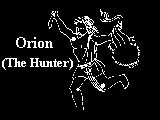
Pavo is named for a peacock in
Greek mythology. Hera, queen of the heavens, used a peacock to pull her chariot through the skies. Her husband Zeus diguised
Io, with whom he was romantically attached, as a young white cow when Hera almost caught them together. Hera assigned Argus,
a giant with a hundred eyes, to keep watch over Io. Zeus had Hermes kill Argus, but Hera put Argus' eyes on the tail of the
peacock.The peacock, therefore, has come to symbolize immortality.

Pegasus is a prominent northern constellation that is also visible in the
Southern Hemisphere. Alothough it does not have any extremely bright stars, Pegasus is the seventh largest constellation and
contains a distinctive figure, the Great Square. The constellation is named for a mythological horse that was given a place
in the heavens by Zeus.
The mytho of Pegasus, the winged horse, begins with his unusual birth.
His mother was the beautiful Medusa, who, after her seduction by Poseidon, the Greek god of water and horses, was turned into
a monstrous Gorgon with serpents coverng her head. Medusa was bheaded by Perseus, and the horse Pegasus was born from a mixture
of sea foam and the blood of Medusa. Pegasus became the horse of the mythic hero Bellerophon, wh tried to ride Mount Olympus
on the winged horse. Bellerophon was thrown to the ground for his arrogance, but Pegasus was reqarded with a place in the
heavens.
The constellation of Pegasus was considered to be the horse of Nimrod,
a hunter mentioned in Genesis.
Perseus is a northern constellation seen moving from northeast
to northwest across the evening sky from October to march. In Greek mythology, Perseus is depicted as a great hero, first
slaying the Gorgon Medusa, then Cetus, the sea monster who was about to kill Andromeda. The stories of Perseus, Andromeda,
and her parents, Cassiopeia and Cepheus, are intertwined. Perseus also rode the winged hors Pegasus, who was the son of Medusa,
whom he slew.
Orion is the brightest of the constellations. It stretches across teh celestial
equator and can therefore be observed from almost any part of the world. orion is among the most spectacular constellations,
with many right stars and scores of fascinating stellar objects. It can be quickly distinguished by four bright stars arranged
in a sloppy rectangle around three stars set in a line -- the famous "belt" of Orion.
In Greek mythology, Orion was a great and handsome hunter, and so the constellation
is often called "Orion, the Hunter." Accoridng to some legends, he won the affection of Artemis, goddess of the hunt and of
the moon. Apollo, her brother, accused Orion of distrating Artemis from her duties. Apollo tricked Artemis into shooting Orion
through the head with an arrow. When she discovered the trick, the grieving Artemis honored Orion in the sky. In other legends,
Orion was punished for his arrogance. The Earth released a scorpion to sting him, and Orion jumped into the sea. Because of
the enmity, the two were placed on opposite sides of the sky, which is why the constellation Scorpius appears in teh
east just as Orion sinks below the horizon in the west.
Most sources picture Orion as a warrior, holding a club above his head
and a lion skin or shield before him.

Sagitta is a constellation of the Northern Hemisphere. This small constellation is surrounded by Vulpecula, Delphinus, and
Aquila, and it resembels an arrow, which the Greeks believed was the arrow of Eros, or Cupid. A neighboring constellation,
Aquila the eagle, was supposedly guarding the arrow for Eros, the god of sensual love.
Other mythical accounts of Sagitta include the story of Eratosthenes,
in which Sagitta represents the arrow Apollo used to kill the Cyclops. Another legend ties the arrow to Prometheus, who had
stolen fire from Zeus and was punished by being chained to a mountain top. There and eagle ate Prometheus' liver each day.
Prometheus' liver grew back each night and the eagle returned daily to torture Prometheus for defying Zeus. The ordeal continued
until Heracles shot the eagle with the arrow that Sagitta represents.

Ursa Major is a north polar constellation and the third largest constellation in the sky. Ursa Major (the name means "Great Bear") is
most famous for containing the Big Dipper, an asterism formed from about half the bright stars in this constellation. The
handle of the dipper represents the tail of the bear, and the alignment of stars in its bowl is useful for locating the North
Pole star. In spring the Dipper's bowl appears upside down to Northern Hemishpere observers, then gradually rights itself
during the summer and fall months.
In Greek mythology, there are several different stories and also different
versions of each one. One of the stories is about Adrastia, the nymph who nursed Zeus. In this myth, Zeus's mother, Rhea,
hid him in a cave to prtect him from his father, who had eaten all his previous children. Zeus later turned Adrastia into
a bear and threw her into the sky. In another myth, Zeus's lover Callisto gave birth to a son, Arcas. Zeus's wife Hera became
furious and turned Callisto into a bear. Later, when Arcas had grown, Hera lured him into attempting to kill the bear, his
own mother. Zeus intervened and hurled the bear into the heavens. As an explanation of why thy tail of the Big Bear (Ursa
Major) is so long is that Zeus stretched it when he swung the bear around to hurl it into the heaens. Arcas later became the
constellation Ursa Minor, the Lesser Bear.

Ursa Minor is a northern circumpolar constellation that contains
the north celestial pole star, Polaris. Ursa Minor (Latin for "little bear") also contains the Little Dipper, an asterism
formed from mos o fthe bright stars in the constellation. The handle of the Little Dipper points toward Polaris.
For the
mythology on Ursa Minor, refer to Ursa major.
|

